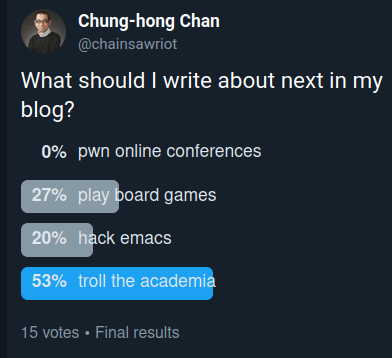chainsawriot
Home | About | ArchiveAcademic Twitter (Satire)
WARNING: This is satire. You have been warned.
Every now and then, the academic talks about whether academic Twitter is toxic. I actually have solid evidence about that.
Exhibit #1: With an anonymous fresh session, I search Google for “academic Twitter is”, the first — and the only — suggestion is “toxic”. The conviction from the collective intelligence is pretty clear.

Exhibit #2: I made an innocent poll on my Twitter asking what I should write next in this blog. With the other three interesting, though-provoking options, the majority voted for “Troll the academia”.

It is pretty clear that some of the people who follow me are pretty toxic. The academia is holy and should not be trolled! Academia is uncontrollable! How dare you! Also, many of them are themselves communication researchers and study the danger of online trolls in their research. If you are communication researchers and you have voted for the “Troll the academia” option, you should now start your self-criticism, Marxist-Leninist style.
With this background, I think I need to educate those toxic people how to properly use academic twitter for holy academic purposes. For other people, following these simple rules can make sure you can survive academic Twitter.
Forget “Publish or Perish”, the new rule is “Kardashianize or be marginalized”
“Publish or Perish” was the mantra of the last millennium. If you are talking about scientific publication, the new mantra is “publish and Perish”. However, no one cares about scientific publication.
You might know the Hirsch Index (H-Index) 1. It is an author-level metric, but it quantifies — at least purportedly — an author’s research productivity as well as the popularity of his or her research. In case you don’t know, there is also the Kardashian Index (K-Index) 2, an author-level metric to quantify the popularity of a researcher on Twitter (no. of followers) relative to his or her research (no. of citations) 3.
It would be nice to have both high H- and K-Indices. But we don’t have unlimited mental resources, you likely need to choose H or K. The worst case is neither H nor K. You can be famous for your science. You can also be famous for being famous on Twitter. The former is pretty hard. The latter is (relatively) easy. Any YouTuber would tell you “Like, Comment, Share” are the currency of power, the new oil.
But how to get the currency of fame? The new mantra is “Kardashianize or be marginalized”. Just as bad publicity is still publicity. Science Kardashians are still… having the word “science” preceding it. But how to Kardashianize yourself? It is simple and it boils down to two words: attention seeking. Human attention is now a scarce commodity. “Like, Comment, Share” are products of human attention. So, do as many attention seeking behaviors as you can.
Here, I provide a 3-step plan for successful Kardashianization.
Kardashianization step 1: You wanna be on top?
The 2000s is remembered as the golden era of reality TV. In the 2020s, well, we are living in a real-life reality TV called social media. Social media is a reality TV that your self-worth is quantified by the “judges” — how much your social media audience give attention to you. Just like being in a reality TV program, the way to make Twitter works is to turn every thing into melodramas. We don’t need nuanced discussion on Twitter, just churn out insignificant, juicy details about your personal life. Whether or not it is related to your professional life doesn’t matter. As the communication researchers would say, academic twitter is a digital assemblage of personal, social, and professional lives, whatever that sentence means. On social media, the first two are kings. Remember the trade off between H and K.
Here are some useful tips:
1. Partake in all memes, fads, tag games etc.
Do you remember “I have a joke about…” jokes? Or “How it started” jokes? If you missed tweeting about those jokes, you missed the wonderful opportunities to seek attention. All memes, viral tweets, fads are great opportunities. Partake in all of them. You need to tweet about these things to be a part of the burgeoning academic society. Auxiliary fads such as Wordle, silicone bubble pop, and Dalgona are also chances you can’t miss.
The same goes with pop culture obsessions. If you still have no access to Netflix, you need to have it NOW! VPN to access the North American Content is also recommended. If you don’t obsess with pop culture, you can’t be a part of the whole. Also, you will not be able to understand pop-culture-based memes. Observe what the academic twitter is currently obsessing with. More likely than not, some brainy-looking TV series such as The Chair, Emily in Paris, or Squid Game; or non-brainy-looking reality shows such as Tidying Up with Marie Kondo or Nailed it! If you like real brainy stuff on Netflix such as boring documentary films, keep them to yourself. You don’t need to tweet about them.
Last but not least: Academic people occasionally like to list out n books, n movies, n TV dramas etc. and then tag their academic friends to make similar lists. This kind of listicle tagging games is usually quite exclusive to the top feeders of the food chain and their PhD students. However, even no one tags you due to your tier level, I still highly recommend you partaking proactively. Just make a similar listicle and tag other academics like a top feeder. Fake it until you make it. As I said previously, Twitter is a place for churning out insignificant juicy details about your personal life. These listicles are the distilled essence of such details.
2. Dramatize
In reality TV, contestants constantly shout at each other because of the dramatic effect. They would probably not shout at people like so in real life. But presenting themselves with such dramatic level make them “social”. Shouting sells.
On academic Twitter, there are two ways to archive such effect. If the object you want to shout at is another academic, it is like committing an academic suicide to shout at him / her in the reality TV style. But you can still shout at him / her in a different style: Twitter is a platform for constantly giving shout-outs. Academic people, like all holy entities such as deities, need constant explicit validation of their abilities. Being shouted out at is thus essential for satisfying such need.
If the object you want to shout at is not a person, you need to exaggerate your grievances (see step 3 below). For example, you find a computer tool — let’s say, R — quite difficult to use. Instead of asking for help or learning how to use R properly, try to dramatize and tweet about the how difficult R is. Tell jokes about “object of type ‘closure’ is not subsettable”. If you don’t mind having your face on Twitter, try to practice your thumbnail face to literally dramatize the visual experience. If you don’t know what thumbnail face is, go to any famous Youtuber’s channel, boomer! If you have a TikTok or something like that, link that to your academic Twitter for serial drama too.
Mid-article repeated WARNING: Again, you are still reading a satire.
Kardashianization step 2: The medium is controls the message
The Canadian media theorist Marshall McLuhan said “The medium is the message.” (1964, p.25) What that truly means is not important. But on Twitter, the medium controls the message. You need to construct the message to cater for the platform and your audience to achieve the maximum attention seeking level. The following are three tips.
1. Abolish content, use hashtags
You don’t need to make the content attractive and interesting to grab attention. Hashtags have replaced the content because of the so-called folksonomic media consumption patterns. Many academic Twitter types, including the author, use tweetdeck to monitor many academic hashtags. So, you need to make at least half of every tweet a list of those academic hashtags: #commtwitter, #highered, #academictwitter, #firstgenprof, #academicchatter, #womenknowstuff, etc. Conference hashtags are mostly communication scholars’ obsessions, but don’t miss putting hashtags such as #ica22 (don’t use #ica2022, unless you want to be policed) too!
2. Abolish expression of emotions, use emojis and animated gifs
Instead of writing and commenting something is funny like IRL (in real life), e.g. “Oh! It is funny!”. Use emojis and animated gifs. For reaction, it is even a cultural phenomenon. You might ask: why? Reason number #1: We might have read and written too much IRL, we don’t want to read and write on Twitter. Reason number #2: We are funny, young, hip academic people! Reason number #3: the embedded animated gif occupies more screen estate than your 256-character textual content. Depending on interface, an animated gif can easily occupy 3 to 4 times the screen estate as a 256-character tweet. See the following for the effect.

By the way, the — perhaps overused — animated gif is searched with the keyword “funny”.
3. Abolish deliberation, use memes
Deliberation is a noble act. It is already quite difficult in real life, don’t even try that on (academic) Twitter. Just produce a meme.

See, I’ve saved 1000 words. Next!
Kardashianization step 3: Birds of a feather tribalize together
In Twitter, you are living in your own bubble. Your followers are more or less similar to you, the same goes with your followees. “Birds of a feather [insert your verb here] together” or “Divided they [insert your verb here]” are still popular title templates for Twitter analytic papers.
Academic Twitter, similar to the vanilla Twitter, is tribal. The tribal nature of Twitter across the political line is well studied. Any random academic talk about Twitter would bring up the famous Adamic and Glance’s red and blue hairballs figure 4. As this blog post is also a random academic talk about Twitter, I think can bring up the famous figure too.

There is no chance one can deliberate on Twitter. Don’t assume academic Twitter is anything different. The bubble is arguably more isolated. It is a small tribal within a tribal. To seek for attention of your audience, you need to take side. R vs Python (or Stata); Tidyverse vs data table vs base; Frequentist vs Bayesian; Communication Research vs Political Science; emacs vs vi (if there is still war between them); Mannheim vs Ludwigshafen. Just take a side.
The unique feature of taking side on academic Twitter is not to show your allegiance to your camp, is to invent your dramatized grievances against the other camp. Let’s take emacs vs vi as an example. You might like vi and have actually no feeling about emacs IRL. But you need to show you despise emacs on Twitter. One way to dramatize your nonexistent grievances is to name-call like Trump. The same playbook of “Crooked Hillary”, “Lyin’ Ted”, or “Low Energy Jeb” can also be played on academic Twitter. Suppose you don’t like tidyverse, try “hegemonic tidyverse”. Everything with the adjective “hegemonic” before it sounds academic and disgusting at the same time.
Debrief (I am serious)
Once again, the above was satire. I can’t stress this enough.
Although I tried very hard to dissociate myself with the academia, I am part of it. I am on Twitter too, so I am also a part of the “academic Twitter” satirized above. So, the above is not a satire of the “third-person” academic Twitter, but a criticism of the “first-person” academic Twitter. This is a self-criticism of what I have done on Twitter. Upon self-reflection, I see what I’ve done on Twitter as ugly. This post serves as a reminder of all the ugly attention seeking behaviors I should not do anymore.
If you find tools that are difficult to use, please seek for help. The R community is famous for being helpful. You can also contact me if you find R difficult. Similarly, academia in general is difficult too. If you have any difficulties, seek help from your IRL academic friends. Twitter, in this regard and in my honest opinion, is not very useful. The above satire mentioned about thumbnail face and TikTok. In general, I don’t think it is a good idea to put your face on Twitter in the age of deepfake and hostility against scientists during the pandemic. Please avoid it at all cost.
Finally, if you want to know how to use Twitter correctly for academic purposes, please use the following authoritative resources.
- Twitter for Scientists by Daniel S. Quintana
- Searles, K., & Krupnikov, Y. (2018). How Not to Get Ratioed and Other Advice for the Savvy Graduate Mentor. Political Communication, 35(4), 669-673. doi
-
Hirsch, J. E. (2005). An index to quantify an individual’s scientific research output. Proceedings of the National academy of Sciences, 102(46), 16569-16572. doi ↩
-
Hall, N. (2014). The Kardashian index: a measure of discrepant social media profile for scientists. Genome biology, 15(7), 1-3. doi ↩
-
Please note that I say “popularity”. It is based on Chan & Grill (2020). I don’t say anything about “quality”. ↩
-
Adamic, L. A., & Glance, N. (2005, August). The political blogosphere and the 2004 US election: divided they blog. In Proceedings of the 3rd international workshop on Link discovery (pp. 36-43). ↩